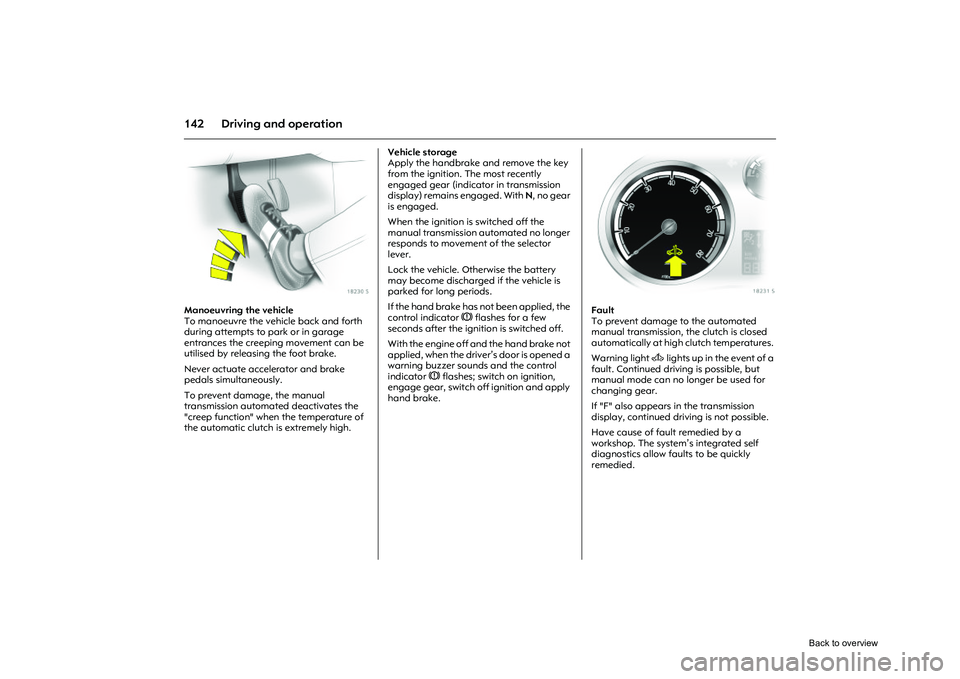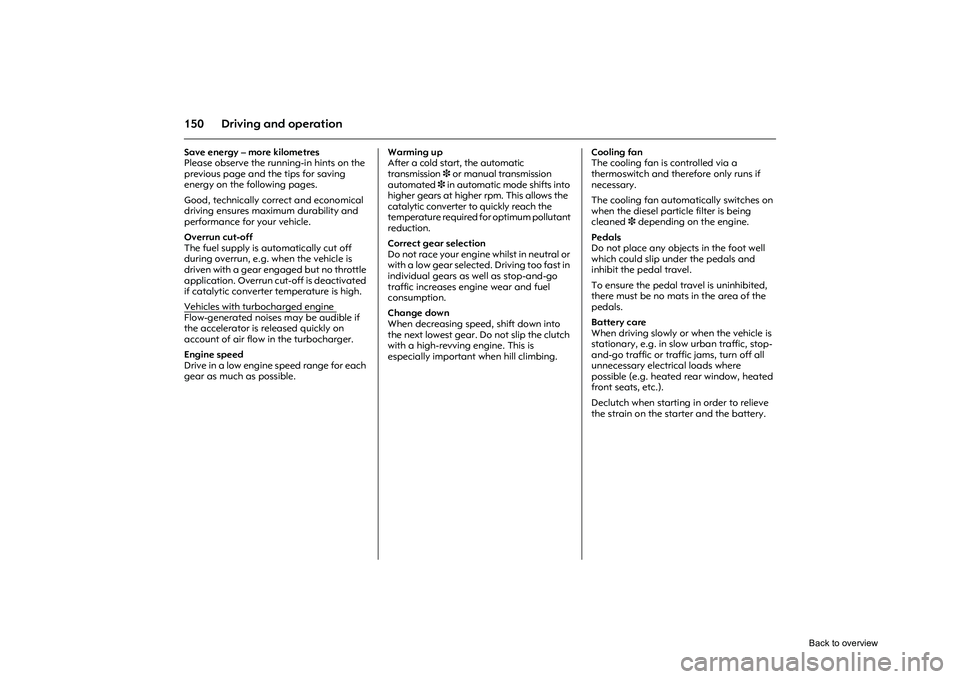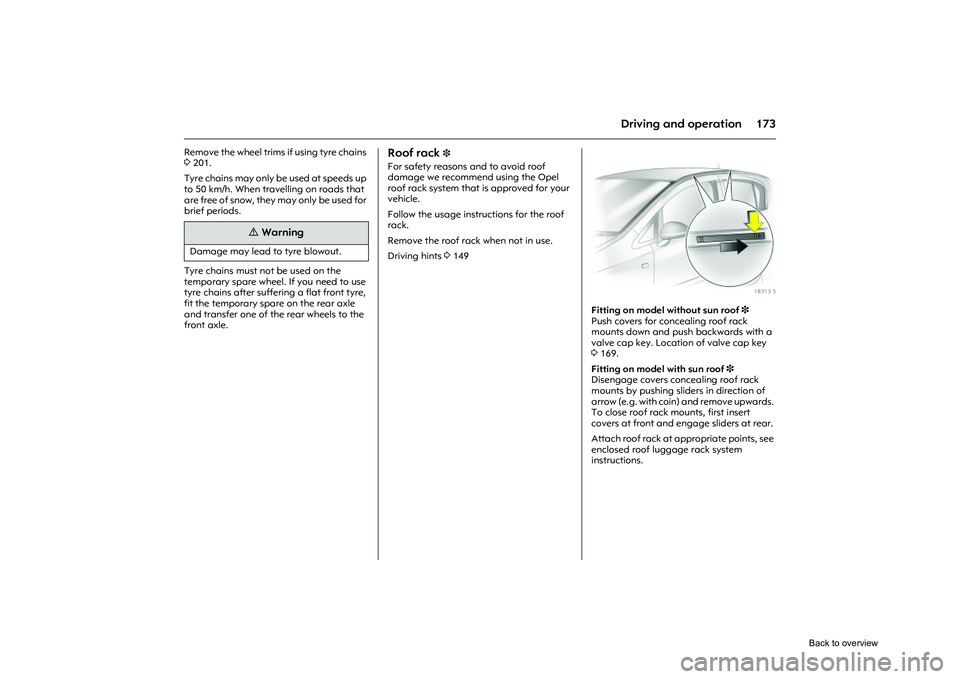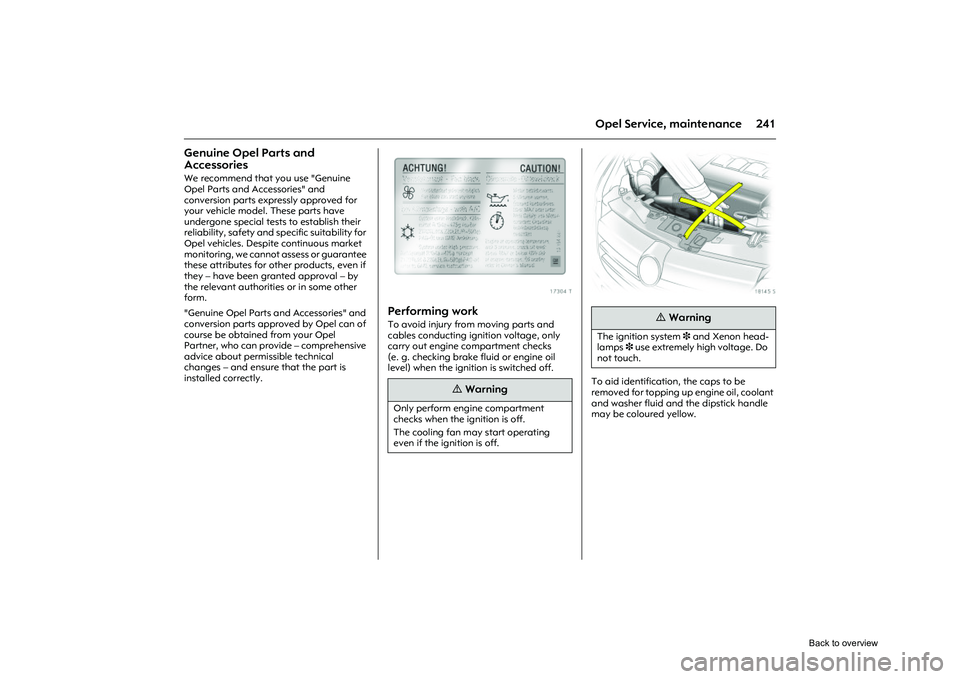ECO mode OPEL CORSA 2009 User Guide
[x] Cancel search | Manufacturer: OPEL, Model Year: 2009, Model line: CORSA, Model: OPEL CORSA 2009Pages: 284, PDF Size: 4.96 MB
Page 146 of 284

140 Driving and operation
Picture no: 18228s.tif
Sport programme =
Shift times are reduced when the Sport
programme is enabled, and the gears are
shifted at higher engine speeds, although
not when cruise control is activated.
The Winter program is switched off by:
z pressing button = again,
z turning off the ignition,
z activating the winter program T .
If the vehicle is switched to manual mode
while the sport programme is active, the
sport programme is in terrupted. The sport
programme resumes upon return to
automatic mode.
Picture no: 18229s.tif
Winter programme T
In the event of difficulties starting off on
slippery roads, press button T ("A" and T
appear on the transmission display). The
manual transmission automated switches
to automatic mode and the vehicle sets off
in second gear.
The Winter programme is switched off by:
z pressing the T button again,
z turning off the ignition,
z when clutch temperature is too high. Activating the winter programme
deactivates the Sport programme, if
selected.
If the vehicle is switched to manual mode
while the winter prog
ramme is active, the
winter programme is interrupted. The
winter programme resumes upon return to
automatic mode.
Back to overview
Page 148 of 284

142 Driving and operation
Picture no: 18230s.tif
Manoeuvring the vehicle
To manoeuvre the vehicle back and forth
during attempts to park or in garage
entrances the creeping movement can be
utilised by releasing the foot brake.
Never actuate accelerator and brake
pedals simultaneously.
To prevent damage, the manual
transmission automated deactivates the
"creep function" when the temperature of
the automatic clutch is extremely high. Vehicle storage
Apply the handbrake and remove the key
from the ignition. The most recently
engaged gear (indicator in transmission
display) remains engaged. With
N, no gear
is engaged.
When the ignition is switched off the
manual transmission automated no longer
responds to movement of the selector
lever.
Lock the vehicle. Otherwise the battery
may become discharged if the vehicle is
parked for long periods.
If the hand brake has not been applied, the
control indicator R flashes for a few
seconds after the ignition is switched off.
With the engine off and the hand brake not
applied, when the driver ’s door is opened a
warning buzzer sounds and the control
indicator R flashes; switch on ignition,
engage gear, switch off ignition and apply
hand brake.
Picture no: 18231s.tif
Fault
To prevent damage to the automated
manual transmission, the clutch is closed
automatically at high clutch temperatures.
Warning light A lights up in the event of a
fault. Continued driving is possible, but
manual mode can no longer be used for
changing gear.
If "F" also appears in the transmission
display, continued driving is not possible.
Have cause of fault remedied by a
workshop. The system’s integrated self
diagnostics allow faults to be quickly
remedied.
Back to overview
Page 156 of 284

150 Driving and operationSave energy – more kilometres
Please observe the running-in hints on the
previous page and the tips for saving
energy on the following pages.
Good, technically correct and economical
driving ensures maximum durability and
performance for your vehicle.
Overrun cut-off
The fuel supply is automatically cut off
during overrun, e.g. when the vehicle is
driven with a gear engaged but no throttle
application. Overrun cut-off is deactivated
if catalytic converter temperature is high.
Vehicles with turbocharged engine Flow-generated noises may be audible if
the accelerator is released quickly on
account of air flow in the turbocharger.
Engine speed
Drive in a low engine speed range for each
gear as much as possible. Warming up
After a cold start, the automatic
transmission
3 or manual transmission
automated 3 in automatic mode shifts into
higher gears at higher rpm. This allows the
catalytic converter to quickly reach the
temperature required for optimum pollutant
reduction.
Correct gear selection
Do not race your engine whilst in neutral or
with a low gear selected. Driving too fast in
individual gears as well as stop-and-go
traffic increases engine wear and fuel
consumption.
Change down
When decreasing speed, shift down into
the next lowest gear. Do not slip the clutch
with a high-revving engine. This is
especially important when hill climbing. Cooling fan
The cooling fan is controlled via a
thermoswitch and therefore only runs if
necessary.
The cooling fan automatically switches on
when the diesel particle filter is being
cleaned
3 depending on the engine.
Pedals
Do not place any objects in the foot well
which could slip under the pedals and
inhibit the pedal travel.
To ensure the pedal travel is uninhibited,
there must be no mats in the area of the
pedals.
Battery care
When driving slowly or when the vehicle is
stationary, e.g. in slow urban traffic, stop-
and-go traffic or traffic jams, turn off all
unnecessary electrical loads where
possible (e.g. heated rear window, heated
front seats, etc.).
Declutch when starting in order to relieve
the strain on the starter and the battery.
Back to overview
Page 179 of 284

173
Driving and operation
Remove the wheel trims if using tyre chains
3201.
Tyre chains may only be used at speeds up
to 50 km/h. When travelling on roads that
are free of snow, they may only be used for
brief periods.
Tyre chains must not be used on the
temporary spare wheel. If you need to use
tyre chains after suffering a flat front tyre,
fit the temporary spare on the rear axle
and transfer one of the rear wheels to the
front axle.
Roof rack
3
For safety reasons and to avoid roof
damage we recommend using the Opel
roof rack system that is approved for your
vehicle.
Follow the usage instructions for the roof
rack.
Remove the roof rack when not in use.
Driving hints 3 149
Picture no: 18313s.tif
Fitting on model without sun roof 3
Push covers for concealing roof rack
mounts down and push backwards with a
valve cap key. Location of valve cap key
3 169.
Fitting on model with sun roof 3
Disengage covers concealing roof rack
mounts by pushing sliders in direction of
arrow (e.g. with coin) and remove upwards.
To close roof rack mounts, first insert
covers at front and engage sliders at rear.
Attach roof rack at appropriate points, see
enclosed roof luggage rack system
instructions.
9
Warning
Damage may lead to tyre blowout.
Back to overview
Page 195 of 284

189
Driving and operation
Driving characteristics, towing tips
Before attaching the trailer/caravan,
lubricate the ball of the trailer/caravan
towing device. However, do not lubricate
the ball if a stabiliser, which acts on the
coupling ball, is being used to damp
hunting.
Check caravan/traile r lighting before
starting to drive. The fog tail lamps on the
vehicle are deactivated when towing a
caravan or trailer.
Trailers with LED turn signals must have a
provision enables lamp monitoring for
commercial bulbs.
Ultrasonic parking sensors 3 are
deactivated in towing mode.
Handling is greatly influenced by the
loading of the trailer/caravan. Loads
should therefore be secured so that they
cannot slip and be placed in the centre of
the trailer/caravan if possible, i.e. above
the axle.
For trailers with low directional control and
for caravans with a permissible gross
vehicle weight of more than 1000 kg, a
speed of 80 km/h must not be exceeded;
use of a roll damper in accordance with the
friction principle is urgently recommended. If the trailer/caravan starts to sway, drive
more slowly, do not attempt to correct the
steering and brake sharply if necessary.
If it is necessary to apply the brakes fully,
depress the brake pedal as hard as
possible.
Remember that the braking distance for
vehicles towing caravans/trailers with and
without brake is always greater than that
for vehicles not towing a caravan/trailer.
When driving downhill, drive in the same
gear as if driving uphill and drive at a
similar speed.
Adjust tyre pressure to the value specified
for full load
3264. Starting on inclines
For vehicles with manual transmission, the
most favourable engine speed when
starting off on an incline is between
2500 and 3000 rpm for petrol engines and
between 2000 and 2200 rpm for diesel
engines. Hold engine speed constant,
engage clutch gradually (let slip), release
hand brake and open throttle. If possible,
the engine speed should not drop during
this procedure.
In vehicles with automatic transmission
3
and manual transmission automated 3 it is
sufficient to give full throttle in D or
(in automatic mode) 3.
Before starting off under extreme
operating conditions, switch off
unnecessary consumers.
Back to overview
Page 247 of 284

241
Opel Service, maintenance
Genuine Opel Parts and
Accessories We recommend that you use "Genuine
Opel Parts and Accessories" and
conversion parts expressly approved for
your vehicle model. These parts have
undergone special tests to establish their
reliability, safety and specific suitability for
Opel vehicles. Despit e continuous market
monitoring, we cannot assess or guarantee
these attributes for other products, even if
they – have been granted approval – by
the relevant authorities or in some other
form.
"Genuine Opel Parts and Accessories" and
conversion parts approved by Opel can of
course be obtained from your Opel
Partner, who can provide – comprehensive
advice about permissible technical
changes – and ensure that the part is
installed correctly.
Picture no: 17304t.tif
Performing work To avoid injury from moving parts and
cables conducting ignition voltage, only
carry out engine compartment checks
(e. g. checking brake fluid or engine oil
level) when the igniti on is switched off.
Picture no: 18145s.tif
To aid identification, the caps to be
removed for topping up engine oil, coolant
and washer fluid and the dipstick handle
may be coloured yellow.
9
Warning
Only perform engine compartment
checks when the ignition is off.
The cooling fan may start operating
even if the ignition is off.
9
Warning
The ignition system 3 and Xenon head-
lamps 3 use extremely high voltage. Do
not touch.
Back to overview
Page 262 of 284

256 Technical DataFuel consumption, CO
2-emissions
Directive 80/1268/EEC (last changed
by 2004/3/EC) has applied for the
measurement of fuel consumption
since 1996.The directive is oriented to actual driving
practices: Urban driving is rated at
approx.
1/3 and off-road driving with
approx.2/3 (urban and extra-urban
consumption). Cold starts and acceleration
phases are also taken into consideration.
The specification of CO
2-emission is also
a constituent of the directive. The figures given must not be taken as a
guarantee for the actual fuel consumption
of a particular vehicle.
All values are based on the EU base model
with standard equipment.
The calculation of fuel consumption as
specified by directive 2004/3/EC takes
account of the vehicle’s kerb weight,
ascertained in accordance with the said
regulation. Optional ex
tras may result in
slightly higher fuel consumption and
CO
2-emission levels than those quoted.
Fuel economy, Protec ting the environment
3 151.
Back to overview
Page 266 of 284

260 Technical DataTable 1, unladen weight
1), passenger car 5-door
1)According to EC Directive, including assumed weights for driver (68 kg), luggage (7 kg) and all fluids (tank 90 % full). ModelEngine Manual transmission Easytronic Automatic transmission
Corsa [kg]
Z 10 XEP 1145––
Z 12 XEP 11601160–
Z 14 XEP 1163–1188
Z 16 LEL 1280––
Z 13 DTJ 1235––
Z 13 DTH 12651265–
Z 17 DTR 1320––
Corsa with air
conditioning system
or climate control
system [kg] Z 10 XEP
1165––
Z 12 XEP 11801180–
Z 14 XEP 1183–1208
Z 16 LEL 1295––
Z 13 DTJ 1255––
Z 13 DTH 12851285–
Z 17 DTR 1340––
Corsa ECO [kg]
Z 13 DTJ 1210––
Corsa ECO with air
conditioning system [kg] Z 13 DTJ
1219––
Back to overview
Page 267 of 284

261
Technical Data
Table 1, unladen weight
1), passenger car 3-door
1)According to EC Directive, including assumed weights for driver (68 kg), luggage (7 kg) and all fluids (tank 90 % full). ModelEngine Manual transmission Easytronic Automatic transmission
Corsa [kg]
Z 10 XEP 1100––
Z 12 XEP 11301130–
Z 14 XEP 1140–1165
Z 16 LEL 1255––
Z 13 DTJ 1205––
Z 13 DTH 12351235–
Z 17 DTR 1278––
Corsa with air
conditioning system
or climate control
system [kg] Z 10 XEP
1120––
Z 12 XEP 11501150–
Z 14 XEP 1160–1185
Z 16 LEL 1270––
Z 13 DTJ 1225––
Z 13 DTH 12551255–
Z 17 DTR 1298––
Corsa OPC [kg]
Z 16 LER 1278––
Corsa OPC with air
conditioning system [kg] Z 16 LER
1298––
Corsa ECO [kg]
Z 13 DTJ 1163––
Corsa ECO with air
conditioning system [kg] Z 13 DTJ
1175––
Back to overview
Page 278 of 284

272 IndexDDashboard, see Instrument panel ............ 6
Data .................................................. 26, 250
Date .......................................................... 96
Daytime running lights .......................... 108
Decommissioning .................................. 249
Deflation detection system ............. 22, 164
Deflation Detection System (DDS) ....... 164
Demisting and defrostingWindows ............................................. 125
With climate control system .............. 131
With the air conditioning system ...... 128
Diesel fuel filter ...................................... 244
Diesel fuel system .......................... 190, 244
Diesel particle filter ........... 46, 85, 150, 157
Dimensions ............................................. 268
Dipped beam ........................................... 11 Bulb replacement ............................... 213
Display ..........................................91, 92, 94
Display mode ......................................... 100
Door locks ......................................... 26, 230
Double load-bay floor ....................... 24, 82
Driving abroad Headlamps ......................................... 116
Driving hints ........................................... 149
EEasytronic ................................................. 15 Driving programmes ......................... 139
Fault .................................................... 142
Interruption of power supply ............ 143
Kickdown ............................................ 141
Selector lever ........................................ 15
Sport programme .............................. 140
Starting off ......................................... 138
Winter programme ............................ 140
Economical driving ................................ 151
Electric sun roof ....................................... 46
Electric windows ...................................... 45
Electrical system ....................208, 249, 267
Electro-hydraulic power assisted steering ............................ 87, 149
Electronic components .......................... 249
Electronic immobiliser ............................. 27
Electronic Stability Program ................. 151
Engine code ...........................251, 252, 253
Engine control indicator ........................ 156
Engine data ........................................... 253
Engine oil ........................................ 239, 242 Additives ............................................ 239
Top up ................................................ 239
Viscosity .............................................. 239
Engine oil consumption ................. 149, 242
Engine oil level ................................. 86, 242
Engine oil pressure .................................. 86
Engine speed ......................................... 150
Engine wash ........................................... 230
Environmental protection ..................... 228 ESP (Electronic Stability Program) ....... 151
Exhaust control indicator ..................... 156
Exhaust gases ........................................ 157
Exhaust system ...................................... 149
Exterior mirrors ........................ 5, 42, 43, 46
FFan ......................................................... 123
Filling station
Engine oil level ................................... 242
Fuel ............................................. 252, 253
Opening the bonnet .......................... 190
Tyre pressure ............................. 152, 264
Vehicle data ....................................... 250
Windscreen washer system .............. 248
First-aid kit (cushion) ............................ 196
Flat tyre .................................................. 204
Flex-Fix system ................................ 24, 174
Fog lamps .............................................. 110 Bulb replacement .............................. 220
Fog tail lamp ......................................... 110 Bulb replacement .............................. 221
Foot brake ............................................. 167
Front passenger airbag .......................... 69
Fuel ......................................... 153, 252, 253
Fuel consumption .......................... 151, 256
Fuel filler cap ......................................... 153
Fuel filter ................................................ 244
Fuel gauge ............................................... 90
Fuel level .................................................. 90
Fuel system, diesel ................................ 190
Fuses ...................................................... 208
Back to overview